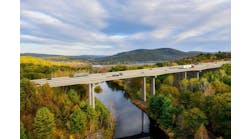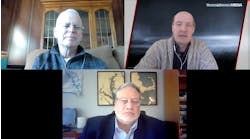At its San Diego convention last December, the American Concrete Pavement Association recognized representatives of Uretek USA, Tomball, Texas, and the Colorado Department of Transportation (CDOT) for pioneering a new technique in concrete pavement restoration with a finalist award. A construction team working for John Springer, CDOT maintenance supervisor from Loveland, made construction history with a pilot project on State Highway 287 near Fort Collins with the world's first full-panel precast slab replacement.
The key to leveling and anchoring the precast slabs was a liquid resin (Uretek 486) that has been used successfully for years to lift and stabilize sunken concrete slabs. In Colorado, the idea to use the liquid resin originated in a brainstorming session of Springer; Mike Hern, Boulder, Colo., maintenance supervisor; and Gary Dewitt, Greeley, Colo., materials supervisor. Springer recalled that Miguel Leman, Concrete Stabilization Technologies, Denver, had successfully leveled and stabilized sinking concrete panels with Uretek.
Mathis and Leman brought together a construction team of Colorado Precast Concrete, Loveland, Colo.; Vogel Concrete, Fort Collins, Colo.; Concrete Coring Co., Denver; Concrete Stabilization Technologies; Northern Colorado Traffic Control, Greeley; and Uretek USA. At the first meeting in September, each member shared expertise on how the project could be accomplished in a short time frame.
"We kicked around how tight we could make the tolerances, the concrete strength, our production time frame and precasting both the injection holes and the stitching slots for the load transfer panels," said Scott Hayward, Colorado Precast Concrete project manager.
Casting the panels required precision because the three used replaced slabs on a curved area, so the measurements differed for each side of the 10-in.-thick panels. Slots for the load transfer devices were precast on the edges. The injection hole pattern ranged from 18 in. to 3 ft apart with 15 to 17 holes per panel. Two rebar mats of grade 60 No. 4 black rebar were used in each panel. Four rebar each spanned both the longitudinal and transverse directions. The slabs weighed up to 25,000 lb, and strength was in excess of 6,000 psi in 28 days curing.
Placement test
From the beginning, there were some load transfer and fitting concerns.
"We first stabilized the adjacent slabs by injecting the Uretek 486 (Circle 915), a void filling stage, we call 'undersealing,'" Mathis explained. "This important stage allowed us to trust the adjacent existing panels to handle the new load received from the stitches connecting the precast panels."
Then Concrete Coring performed the saw cutting. Vogel Concrete removed the concrete and prepared the Class 6 base material 2 in. lower than the finished grade. Colorado Precast Concrete brought the panel to the site and maneuvered it into place.
"Our biggest concern was would the panel fit?" Leman said. To everyone's relief it did. "CDOT allowed us 1/2 to 3/4 in. tolerances on the panels, but we manufactured them to within 1/8 in. of the field measurements," Hayward explained.
Then Concrete Stabilization Technologies (CST) pumped the liquid resin through the nickel-size injection holes to raise the panels and glue them in place. The CST crew used a laser level to lift the concrete pavement to within an 1/8 in. of the target elevation. According to Mathis, the efficiency of the Uretek method comes from injecting a liquid with the viscosity of a 3-in-1 oil that first aggressively spreads out under the slab. Then this liquid expands to fill voids and create a large lift area. The closed-cell, high-density polyurethane reaches 90% of its strength in just 15 minutes.
The last step was stitching the precast panels to the adjacent panels using Uretek's Stitch-in-Time load transfer process. Slots were cut into the adjacent slabs to accommodate the 1/4-in.-thick by 5-in.-deep by 3-ft-long fiberglass load transfer panels. After inserting the fiberglass panels, workers filled the slots with a joint sealer.
The initial cost ran 10 to 15% more than cast-in-place slabs, but CDOT expected to refine the costs in future proj-ects.
"We're doing this to satisfy our customers by not tying up traffic for the period you need for concrete to cure," Springer said.
On to the next
CDOT also replaced nine precast slabs on the U.S. 85 bypass through Greeley and 42 badly deteriorated slabs on I-25 at various locations between Mead and Loveland. The slabs selected for replacement received a score of 8, with 10 being the worst, according to Springer.
Technology Constructors Inc., Arvada, Colo., handled the installation of slab replacements on the U.S. 85 bypass which runs through Greeley. This is a busy area which carries a lot of truck traffic, according to Michael Command, P.E., CDOT project engineer, Loveland. The first replacements--seven panels in the northbound lane and two in the southbound lane--were done during the day.
With success on U.S. 85, funds were rolled over into the next fiscal year to continue replacing 18 panels on I-25. Since I-25 experiences peak traffic flows of 3,200 vehicles an hour, the replacements took place between 9 p.m. and 5 a.m. on Sunday through Thursday nights.
"Because the joints were skewed, we had to take six measurements per panel," Command explained.
The panels were cast to a critical 3/4 in. tolerance and varied from 6 to 8 in. thick.
One key adjustment made as work began was reducing the panel thickness to 61/2 in. to accommodate a whitetopping portion of the job. The change allowed work on I-25 to progress smoothly and the time schedule was consistently met so the road could be open to traffic by 5 a.m.
Because the process proved viable, another contract was planned to replace 24 more deteriorated panels on I-25.
They thought of it first
In California, Tom Brannon, District 3 California Department of Transportation (Caltrans) maintenance, first suggested using Uretek to anchor and level a precast panel back in 1998. Colorado, however, beat California to the actual application.
Brannon has been encouraging Caltrans to put out bids of repair using precast and compare them to bids involving conventional repairs. Brannon oversaw the first precast replacement in District 3, a 12-ft by 15-ft slab in the No. 2 lane northbound of State Highway 51 in Sacramento, known as business route I-80. Here, traffic averages 160,000 vehicles daily with 60,600 at peak time.
The slab was successfully installed at night and more than 24 Caltrans representatives have visited the site to view the work.
Roy Pool, Caltrans District 7 region manager, worked with Don Moody, EagleLift Inc., Walnut, Calif., to coordinate the replacement of five deteriorated slabs on the Route 60 freeway, a westbound truck route into Los Angeles and San Pedro which was opened back in 1971. Slab replacement is expected to provide an additional 10 years of wear, even with increased traffic and heavier trucks. Traffic count in this area is 200,000 vehicles daily with heavy truck traffic.
Caltrans controlled traffic while EagleLift directed the crew in a six-hour overnight replacement of two panels on Route 60 eastbound. The crew took seven hours to replace the three panels in the westbound lanes. EagleLift performed Uretek undersealing, leveling of the slab and the installation of the load transfer devices. McLoughlin Engineering, Rancho Cucamonga, Calif., performed the saw-cutting, excavation, base preparation, delivery and placement of the precast slabs. Concrete Products, Corona, Calif., precast the panels.


